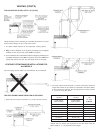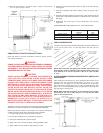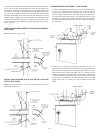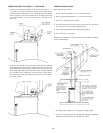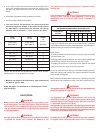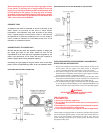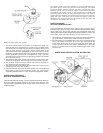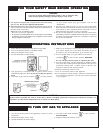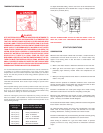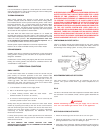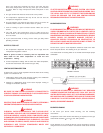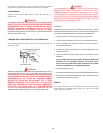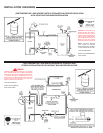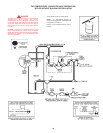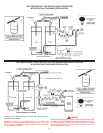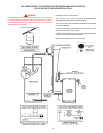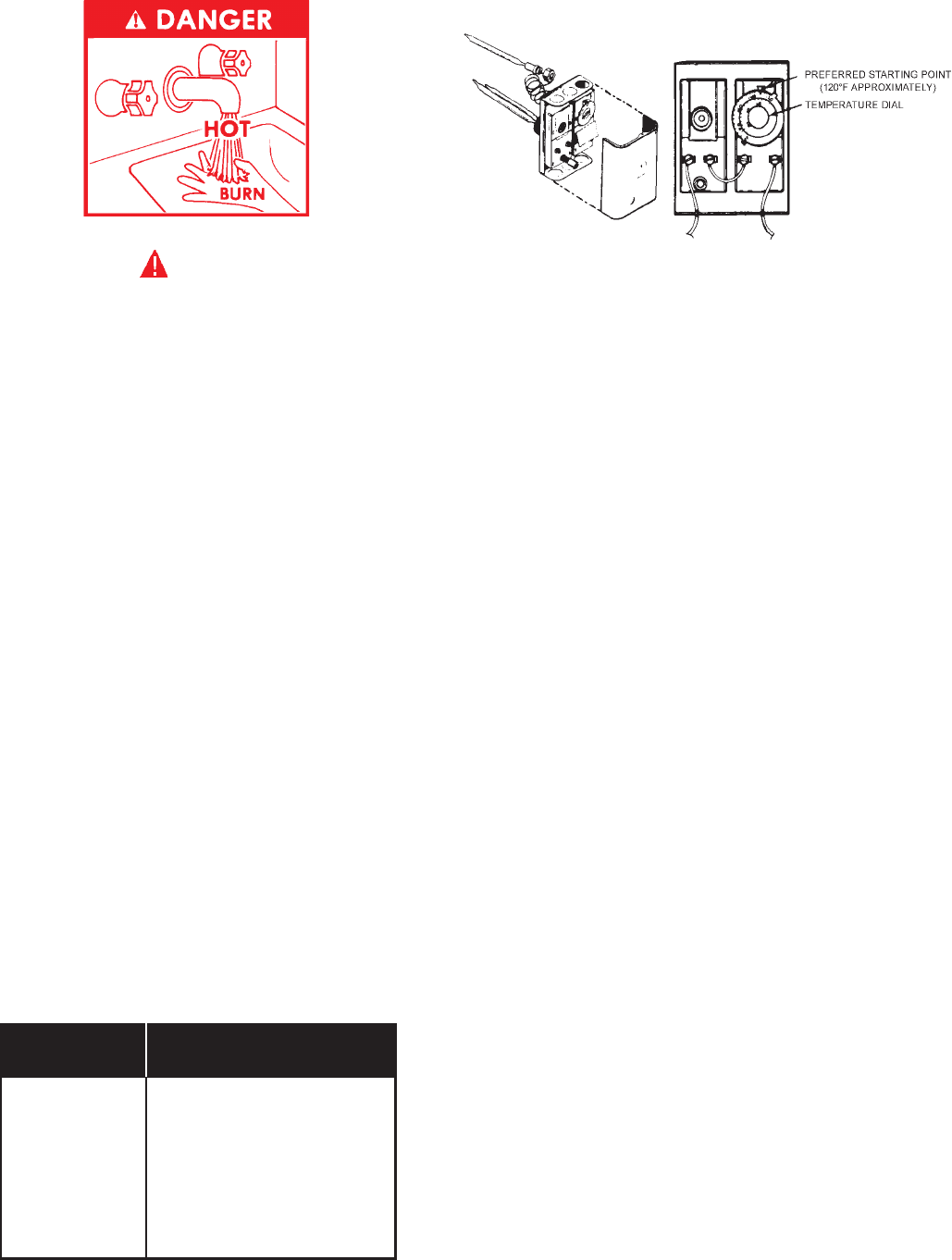
24
TEMPERATURE REGULATION
DANGER
HOT WATER CAN SCALD: WATER HEATERS ARE INTENDED TO
PRODUCE HOT WATER. WATER HEATED TO A TEMPERATURE
THAT WILL SATISFY SPACE HEATING, CLOTHES WASHING, DISH
WASHING, AND OTHER SANITIZING NEEDS CAN SCALD AND
PERMANENTLY INJURE YOU UPON CONTACT. SOME PEOPLE ARE
MORE LIKELY TO BE PERMANENTLY INJURED BY HOT WATER
THAN OTHERS. THESE INCLUDE THE ELDERLY, CHILDREN, THE
INFIRM, OR PHYSICALLY/MENTALLY HANDICAPPED. IF ANYONE
USING HOT WATER IN YOUR HOME FITS INTO ONE OF THESE
GROUPS OR IF THERE IS A LOCAL CODE OR STATE LAW
REQUIRING A SPECIFIC HOT WATER TEMPERATURE AT THE TAP,
THEN YOU MUST TAKE SPECIAL PRECAUTIONS. NEVER ALLOW
SMALL CHILDREN TO USE A HOT WATER TAP, OR TO DRAW THEIR
OWN BATH WATER. NEVER LEAVE A CHILD OR HANDICAPPED
PERSON UNATTENDED IN A BATHTUB OR SHOWER.
It is recommended that lower water temperatures be used to avoid the risk
of scalding. It is further recommended, in all cases, that the water
temperature be set for the lowest temperature that satisfies your hot water
needs. This will also provide the most energy efficient operation of the
water heater.
SETTING THE WATER HEATER TEMPERATURE AT 120°F (49° C) WILL REDUCE
THE RISK OF SCALDS. Some states require settings at specific lower
temperatures.
Short repeated heating cycles caused by small hot water uses can cause
temperatures at the point of use to exceed the thermostat setting by up to
20°F (13°C). If you experience this type of use you should consider using
lower temperature settings to reduce scald hazards.
Valves for reducing the point-of-use temperature by mixing cold and hot
water are available. Also available are inexpensive devices that attach to
faucets to limit hot water temperatures. Contact a licensed plumber or the
local plumbing authority.”
To adjust thermostat setting, remove outer cover of the thermostat. The
thermostat’s adjustment dial is labeled with a range of settings between
120°F (49° C) to 180°F (82° C).
SHOULD OVERHEATING OCCUR OR THE GAS SUPPLY FAIL TO
SHUT OFF, TURN “OFF” THE MANUAL GAS CONTROL VALVE TO
THE APPLIANCE.
START UP CONDITIONS
CONDENSATION
Whenever the water heater is filled with cold water, a certain amount of
condensation will form while the burner is on. A water heater may
appear to be leaking when in fact the water is condensation. This
usually happens:
a. When a new water heater is filled with cold water for the first time.
b. When gas burns and water vapor is produced in water heaters,
particularly high efficiency models where flue temperatures are
lower.
c. When you use large amounts of hot water in a short time and the refill
water is very cold.
Moisture from the products of combustion condense on the cooler tank
surfaces and form drops of water which may fall onto the burner or other
hot surfaces to produce a “sizzling” or “frying” noise.
Excessive condensation can cause pilot outage due to water running
down the flue tube onto the main burner and putting out the pilot.
Because of the suddenness and amount of water, condensation water
may be diagnosed as a “tank leak”. After the water in the tank warms up
(about 1-2 hours), the condition should disappear.
Do not assume the water heater is leaking until there has been enough time
for the water in the tank to warm up.
An undersized water heater will cause more condensation. The water
heater must be sized properly to meet the demands for hot water
including dishwashers, washing machines and shower heads.
Excessive condensation may be noticed during the winter and early spring
months when incoming water temperatures are at their lowest.
Good venting is essential for a gas fired water heater to operate
properly as well as to carry away products of combustion and water
vapor.
Temperature Time to Produce 2nd & 3rd
Settings Degree Burns on Adult Skin
180°F (82°C) Nearly Instantaneous
170°F (77°C) Nearly Instantaneous
160°F (71°C) About 1/2 Second
150°F (65°C) About 1 - 1/2 Seconds
140°F (60°C) Less than 5 Seconds
130°F (54°C) About 30 Seconds
120°F (49°C) More than 5 Minutes



